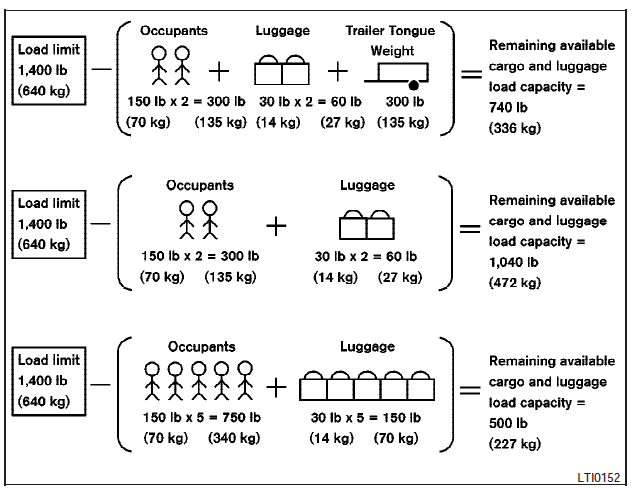Vehicle load capacity
Do not exceed the load limit of your vehicle shown as The combined weight of occupants and cargo on the Tire and Loading Information label. Do not exceed the number of occupants shown as Seating Capacity on the Tire and Loading Information label.
To get the combined weight of occupants and cargo, add the weight of all occupants, then add the total luggage weight. Examples are shown in the following illustration.

Example
Steps for determining correct load limit 1. Locate the statement The combined weight of occupants and cargo should never exceed XXX kg or XXX lbs on your vehicles placard.
2. Determine the combined weight of the driver and passengers that will be riding in your vehicle.
3. Subtract the combined weight of the driver and passengers from XXX kg or XXX lbs.
4. The resulting figure equals the available amount of cargo and luggage load capacity. For example, if the XXX amount equals 1400 lbs. and there will be five 150 lb. passengers in your vehicle, the amount of available cargo and luggage load capacity is 650 lbs. (1400-750 (5 X 150) = 650 lbs) or (640-340 (5 X 70) = 300 kg.).
5. Determine the combined weight of luggage and cargo being loaded on the vehicle. That weight may not safely exceed the available cargo and luggage load capacity calculated in Step 4.
6. If your vehicle will be towing a trailer, load from your trailer will be transferred to your vehicle. Consult this manual to determine how this reduces the available cargo and luggage load capacity of your vehicle.
Before driving a loaded vehicle, confirm that you do not exceed the Gross Vehicle Weight Rating (GVWR) or the Gross Axle Weight Rating (GAWR) for your vehicle.
See Measurement of Weights later in this section.
Also check tires for proper inflation pressures.
See the Tire and Loading Information label.
See also:
Owner’s Manual/Service Manual order information
A genuine NISSAN Service Manual is the best
source of service and repair information for your
vehicle. Filled with wiring diagrams, illustrations
and step-by-step diagnostic and adjustment procedur ...
Opener operation
The fuel-filler door release is located on the floor
to the left of the driver’s seat. To open the fuelfiller
door, pull up the release. To lock, close the
fuel-filler door securely. ...
List of voice commands
When you press and release the
button on
the steering wheel, you can choose from the
commands on the Main Menu. The following
pages describe these commands and the commands
in each sub-me ...
